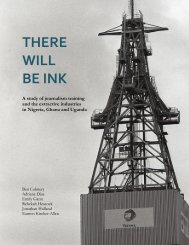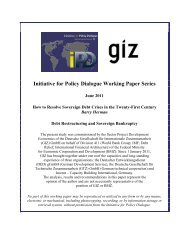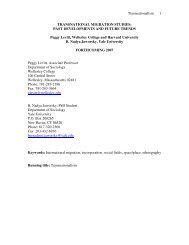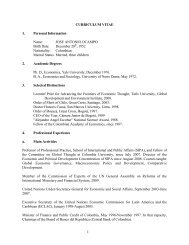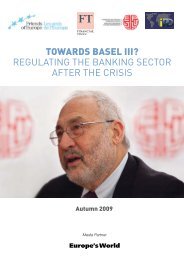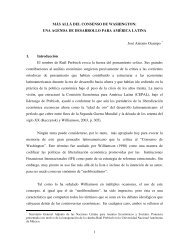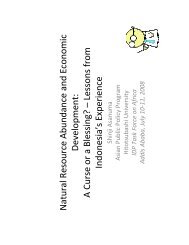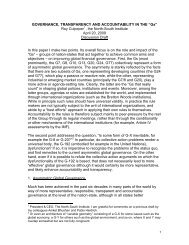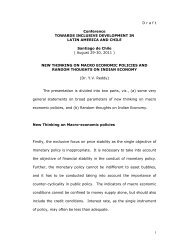Paper - Initiative for Policy Dialogue
Paper - Initiative for Policy Dialogue
Paper - Initiative for Policy Dialogue
Create successful ePaper yourself
Turn your PDF publications into a flip-book with our unique Google optimized e-Paper software.
18<br />
growth and “near sufficient” <strong>for</strong> preventing a growth collapse. And it was estimated to<br />
add two percentage points to per capita growth.<br />
Whilst this analysis was of considerable interest, its value in providing answers to<br />
how to get on the path of sustained, rapid growth was seen by several commentators as<br />
somewhat limited. One comment was that what we need is a better understanding of how<br />
to get and stay on the path of rapid growth, whilst what the anti-growth syndrome showed<br />
was that “if you stop doing stupid things you could get an extra 2% growth”. At any rate,<br />
we really need to parse more carefully the different elements of the anti-growth syndrome<br />
since in some sense many of the fastest growers in East Asia could be said to have at least<br />
some elements of the syndrome, such as “excessive regulation”, to a comparable degree<br />
as African “non-growers”. This was so, in this view, not only in the original four East<br />
Asian “miracle” economies but subsequently in such countries as Malaysia, Thailand and<br />
Indonesia. And perhaps this was the case even more so in the biggest and brightest<br />
growth star, China, and the other two great success stories of the past 25 years or so,<br />
India and Vietnam. The World Bank’s business environment surveys, which focus on<br />
many aspects of the syndrome, consistently rate these countries poorly e.g. China and<br />
India were ranked 91 st and 115 th, out of 155 countries in 2006. Moreover, in light of the<br />
global financial crisis, or even the East Asian crisis a decade earlier, insufficient<br />
regulation can be as much of a problem as too much regulation so the issues is not so<br />
much whether regulation is excessive or not but rather what constitutes an appropriate<br />
regulatory framework.<br />
The other aspect of the AERC project that received a great deal of attention was the<br />
distinction it made among different African countries based on geography. This strand of<br />
the AERC project is also reflected in the Ndulu et al. book referred to above 25 . It<br />
distinguished three groups of African countries: (a) resource rich; (b) resource poor<br />
landlocked and (c) resource scarce coastal. Each of them roughly accounts <strong>for</strong> about onethird<br />
of Africa’s population. For the first group, the central issue is said to be how to<br />
manage public expenditures and deal with the resource curse. The second group was said<br />
to be pretty much a distinctive African phenomenon with not particularly promising<br />
prospects. Their growth is especially dependent on their neighbors: they need to get their<br />
neighbors to get their act together. The third group was deemed to be the one with the<br />
option of attempting to emulate East Asia or pursuing “non-natural-resource-export-led”<br />
growth.<br />
Two of the chapters in the recent anthology on Africa, edited by John Page and<br />
Delphin Go supports the view that policy re<strong>for</strong>ms were central, though obviously high<br />
export prices helped: “The analysis confirms a trend break in the mid-1990s, identifying<br />
a growth acceleration that is due not only to favorable terms of trade and greater aid, but<br />
also to better policy…………as a result the likelihood of growth deceleration has<br />
declined significantly. Nonetheless, the sustainability of that growth is fragile, because<br />
25 Reproduced in summary <strong>for</strong>m in the GSC report Commission on Growth and Development (2008) op.cit<br />
.pp74-75.



